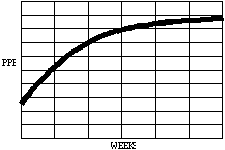FREQUENCY: For a given crystal cut, lower frequency crystals exhibit superior stability and, for a given frequency, the higher overtone crystals will usually provide the best stability. A simple rule of thumb is, “the more quartz the better” down to about 5 MHz below which frequency dividers are usually the best choice. High frequency oscillators may include phase-locked loops or frequency multipliers to take advantage of a low frequency crystal’s stability. Multiplied oscillators are preferred above 120 MHz when stability is a key issue.
AGING: New, high quality ovenized quartz crystals typically exhibit small, positive frequency drift with time unrelated to external influences. A significant drop in this “aging” rate occurs after the first few weeks of operation at the operating temperature. Ultimate aging rates below 0.1 PPB per day are achieved by the highest quality crystals and 1 PPB per day rates are commonplace. Significant negative aging (dropping frequency) indicates a bad crystal – probably a leaking package.

A typical aging curve for a new ovenized oscillator.
TEMPERATURE: The primary effect of temperature variations is to change the oscillator’s frequency. Oven oscillators offer the best temperature stability and largely avoid many of the problems associated with activity dips. Activity dips are drops in crystal Q which can appear in narrow temperature windows causing sudden frequency shifts and amplitude variations. Temperature stability below 0.1 PPB can be achieved but the aging rate often dominates the frequency error budget after only a few days. The specification should state whether the stability specification is peak-to-peak over the entire range or whether it is relative to room temperature. Variation from room temperature is a popular method of specification since the oscillator is usually tuned at room temperature. Non-oven XOs and TCXOs may drift slowly to a new frequency after the ambient temperature changes since the internal thermal time constants can be fairly long.
RETRACE: When power is removed from an oscillator, then re-applied several hours later, the frequency will stabilize at a slightly different value. This “retrace” error is usually specified for a twenty-four hour off-time followed by a warm-up time sufficient to allow complete thermal equilibrium. Retrace errors often diminish after warming as though the crystal walks back down its aging curve when cold and then exponentially approaches the previous drift curve when activated. Oscillators stored at extremely cold temperatures for extended periods of time may exhibit a frequency vs. time curve much like the initial “green” aging curve of a new crystal. In addition to the crystal related effects described above, mechanical shifts can also occur due to the thermal stresses from heating and cooling the oven structure. A common retrace error source is the mechanical device used to adjust the oscillator’s frequency. Precision, multi-turn variable capacitors exhibit good retrace but a good practice is to turn the screw back slightly after setting to relieve any stress. Most Wenzel oscillators use special precision potentiometers which exhibit an unusually low amount of retrace and hysterisis.